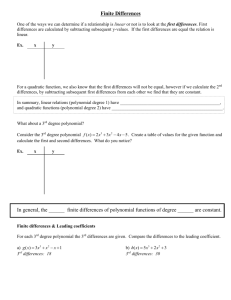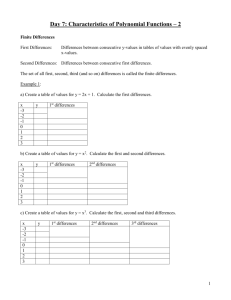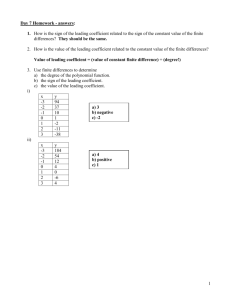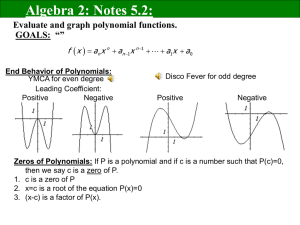6.9 Curve Fitting with Polynomial Models - ASB Bangna
advertisement
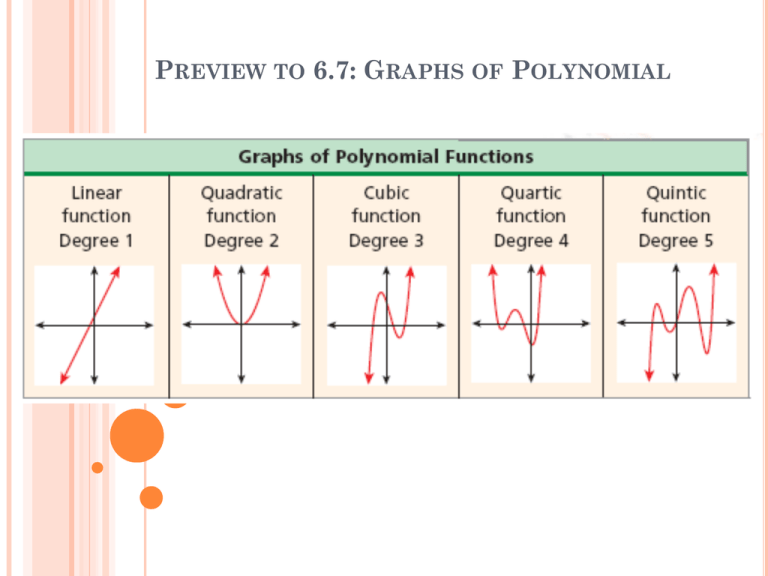
PREVIEW TO 6.7: GRAPHS OF POLYNOMIAL Example 1: Determining End Behavior of Polynomial Functions Identify the leading coefficient, degree, and end behavior. A. Q(x) = –x4 + 6x3 – x + 9 Example 2A: Using Graphs to Analyze Polynomial Functions Identify whether the function graphed has an odd or even degree and a positive or negative leading coefficient. 6.9 CURVE FITTING WITH POLYNOMIAL MODELS Learning Targets: •Use finite differences to determine the degree of a polynomial that will fit a given set of data. •Use technology to find polynomial models for a given set of data. Why are we learning this? The table shows the closing value of a stock index on the first day of trading for various years. To create a mathematical model for the data, you will need to determine what type of function is most appropriate. Then you can make predictions and make money money money! WHAT DO WE NEED TO DO TO CREATE THESE MODELS (FUNCTIONS)? Analyze the Differences between the y-values! Example 1A: Using Finite Differences to Determine Degree Use finite differences to determine the degree of the polynomial that best describes the data. x y 4 –2 6 4.3 8 8.3 10 12 14 10.5 11.4 11.5 The x-values increase by a constant 2. Find the differences of the y-values. y –2 4.3 8.3 10.5 11.4 11.5 First differences: 6.3 4 2.2 0.9 0.1 Not constant Second differences: –2.3 –1.8 –1.3 –0.8 Not constant Third differences: 0.5 0.5 0.5 Constant Conclusion: Once you have determined the degree of the polynomial that best describes the data, you can use your calculator to create the function. Example 2: Using Finite Differences to Write a Function The table below shows the population of a city from 1960 to 2000. Write a polynomial function for the data. Year 1960 1970 1980 1990 2000 Population (thousands) 4,267 5,185 6,166 7,830 10,812 Step 1 Find the finite differences of the y-values. First differences: 918 Second differences: Third differences: 981 63 1664 683 620 2982 1318 635 Close Step 2 Use the cubic regression feature on your calculator. f(x) ≈ 0.10x3 – 2.84x2 + 109.84x + 4266.79 Often, real-world data can be too irregular for you to use finite differences or find a polynomial function that fits perfectly. In these situations, you can use the regression feature of your graphing calculator. The statistical study of the relationship between variables is called regression. Correlation is the strength and direction of the linear relationship between two variables. We can determine a function to model the data which by using the regression feature on our graphing calculator. The correlation coefficient r is a measure of how well the data set is fit by a linear model (the closer r is to 1, the better the model). The coefficient of determination r^2 shows how well a higher degree model fits the data (the close r^2 is to 1, the better the fit). Example 3: Curve Fitting Polynomial Models The table below shows the opening value of a stock index on the first day of trading in various years. Use a polynomial model to estimate the value on the first day of trading in 2000. Year 1994 1995 1996 1997 1998 1999 Price ($) 683 652 948 1306 863 901 Step 1 Choose possible degrees of the polynomial model by making a scatter plot of the data in graphing calculator. Analyze: Now what? cubic: R2 ≈ 0.5833 quartic: R2 ≈ 0.8921 The quartic function is more appropriate choice. Example 3 Continued Step 2 Write the polynomial model. The data can be modeled by f(x) = 32.23x4 – 339.13x3 + 1069.59x2 – 858.99x + 693.88 Step 3 Find the value of the model corresponding to 2000. 2000 is 6 years after 1994. Substitute 6 for x in the quartic model. f(6) = 32.23(6)4 – 339.13(6)3 + 1069.59(6)2 – 858.99(6) + 693.88 Based on the model, the opening value was about $2563.18 in 2000.
